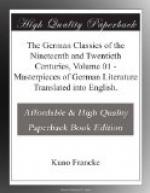echo to die away. In this austerity of concentration
the German “Novelle,” the one rigidly artistic
form of German prose, is related to the “Short
Story” which has been so eagerly heralded in
recent times, especially by America. The “Novelle”
differs, however, from this form of literary composition,
which Maupassant cultivated with the most masterly
and unrivaled success, by its subordination to a climax;
whereas the Short Story, in reality, is usually a
condensed novel, that is to say, the history of a
development concentrated in a few incidents. Our
literature also possesses such short “sketches,”
but the love of psychological detail in the development
of the plot nearly always results in the greater diffuseness
of the novel. The real “Novelle” is,
however, at least as typical of the Germans as the
Short Story is of the Americans, and in no other form
of literary composition has Germany produced so many
masters as in this—and in the lyric.
For the latter is closely related to the German “Novelle”
because it loves to invest the way to and from the
culminating point with the charm produced by a certain
mood, as the half-German Bret Harte loves to do in
similar artistic studies, but the Russian Tschechow
never indulges himself in, and the Frenchman Maupassant
but seldom. On this account our best writers of
“Novellen” have also been, almost without
exception, eminent lyric poets; such were Goethe,
Tieck, Eichendorff, Moerike, Keller, Heyse, Theodor
Storm and C.F. Meyer; whereas, in the case of
Marie von Ebner-Eschenbach, who otherwise would form
an exception, even what appears to be a “Novelle”
is in reality a “small novel.”
The novel, on the contrary, still enjoys in Germany
the dangerous privilege of formlessness. In its
language it varies from the vague lyric of romantic
composition to the bureaucratic sobriety of mechanically-compiled
studies of real life. In its outline, in the
rhythm of its construction, in the division of its
parts and the way in which they are brought into relief,
it has, in spite of masterly individual performances,
never attained a specific literary form, such as has
long been possessed by the English and the French novels.
Likewise the inclination, sanctioned by Goethe and
the Romantic school, to interpolate specimens of the
least formed half-literary genres—namely,
letters and diaries—worked against the adoption
of a fixed form, notwithstanding that this expedient
augmented the great—often indeed too great—inner
richness of the German novel. Thus the German
novel, as well as the so justly favorite form of letters
and diaries, is of infinitely more importance as a
human or contemporary “document” than
as a direct work of art. We have, however, already
drawn attention to the fact that the never-failing
efforts to clothe the novel in a more esthetically
pure form have, in our own day, happily increased.




